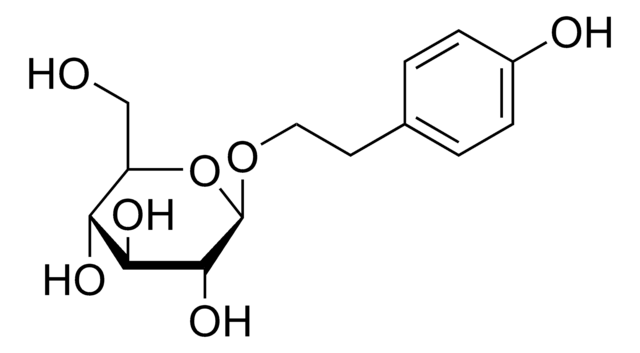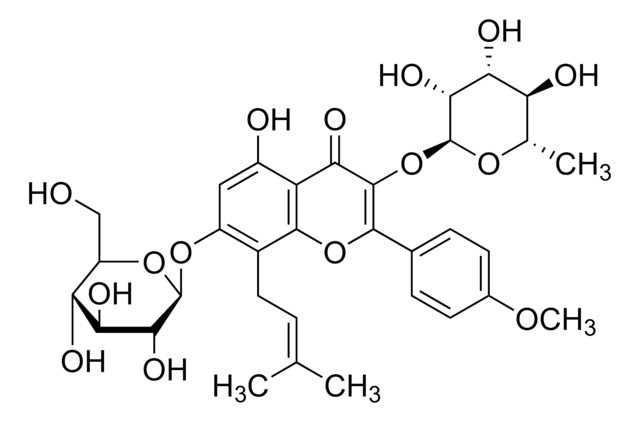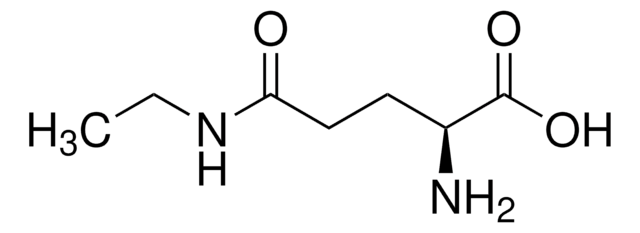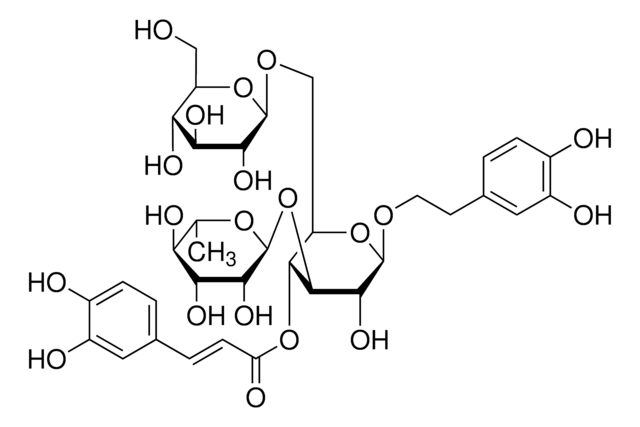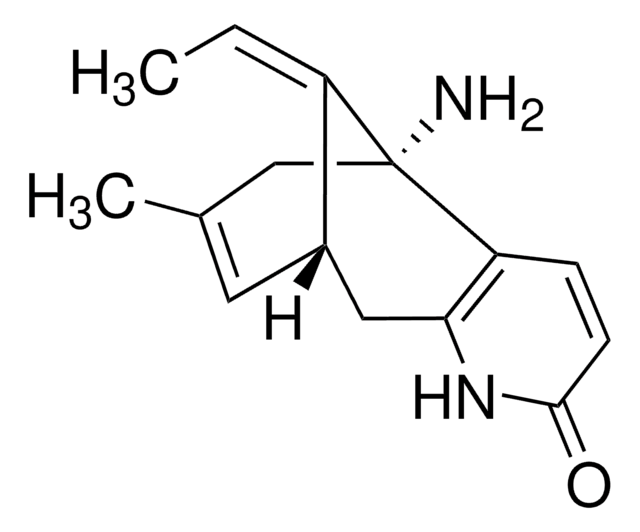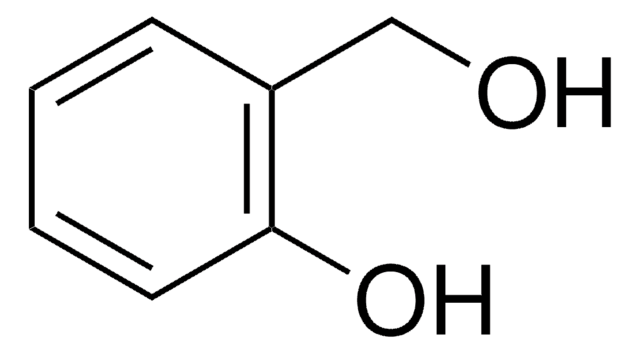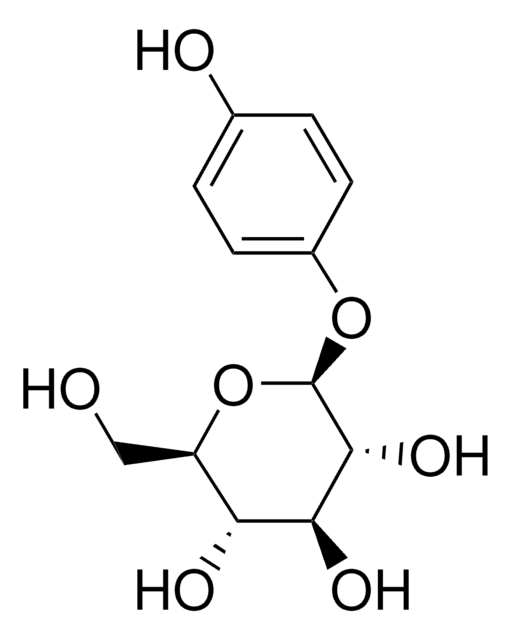43866
Salidroside
analytical standard
동의어(들):
2-(4-Hydroxyphenyl)ethyl β−D-glucopyranoside, p-Hydroxyphenethyl glucopyranoside, Rhodioloside, Rhodosin, Tyrosol a-(β-D-glucopyranoside)
로그인조직 및 계약 가격 보기
모든 사진(1)
About This Item
실험식(Hill 표기법):
C14H20O7
CAS Number:
Molecular Weight:
300.30
MDL number:
UNSPSC 코드:
85151701
PubChem Substance ID:
NACRES:
NA.24
추천 제품
Grade
analytical standard
Quality Level
분석
≥98.0% (HPLC)
광학 활성
[α]/D -29±2°, c = 0.5 in methanol
기술
HPLC: suitable
gas chromatography (GC): suitable
응용 분야
food and beverages
형식
neat
SMILES string
OC[C@H]1O[C@@H](OCCc2ccc(O)cc2)[C@H](O)[C@@H](O)[C@@H]1O
InChI
1S/C14H20O7/c15-7-10-11(17)12(18)13(19)14(21-10)20-6-5-8-1-3-9(16)4-2-8/h1-4,10-19H,5-7H2/t10-,11-,12+,13-,14-/m1/s1
InChI key
ILRCGYURZSFMEG-RKQHYHRCSA-N
유사한 제품을 찾으십니까? 방문 제품 비교 안내
관련 카테고리
일반 설명
Salidroside is one of the major phenolic glycoside extracted from Rhodiola rosea L(, which can show a broad-spectrum of pharmacological properties like anti-aging, anti-oxidant, anti-cancer and anti-inflammation.
애플리케이션
Refer to the product′s Certificate of Analysis for more information on a suitable instrument technique. Contact Technical Service for further support.
생화학적/생리학적 작용
Salidroside, the 8-O-β-D-glucoside of tyrosol, is the main bioactive component of Rhodiola species and is found mainly in the plant roots. It is biosynthesised in the tyrosine metabolism, with glucosylation of tyrosol being the final step. It has been reported to be neuroprotective and one of the compounds responsible for the antidepressant and anxiolytic actions of Rhodiola rosea.
포장
Bottomless glass bottle. Contents are inside inserted fused cone.
신호어
Warning
유해 및 위험 성명서
Hazard Classifications
Eye Irrit. 2
Storage Class Code
11 - Combustible Solids
WGK
WGK 3
Flash Point (°F)
Not applicable
Flash Point (°C)
Not applicable
이미 열람한 고객
Li Zhang et al.
European journal of pharmacology, 564(1-3), 18-25 (2007-03-14)
Oxidative stress plays an important role in Alzheimer's disease and other neurodegenerative disorders. Salidroside, a phenylpropanoid glycoside isolated from Rhodiola rosea L, shows potent antioxidant property. In this paper, the neuroprotective effects of salidroside on hydrogen peroxide (H2O2)-induced apoptosis in
Xue Li et al.
Blood, 119(18), 4162-4173 (2012-03-20)
Salidroside is a phenylpropanoid glycoside isolated from the medicinal plant Rhodiola rosea, which has potent antioxidant properties. Here we show that salidroside prevented the loss of hematopoietic stem cells (HSCs) in mice under oxidative stress. Quiescent HSCs were recruited into
P T Linh et al.
Archives of pharmacal research, 23(4), 349-352 (2000-09-08)
A reversed-phase high performance liquid chromatographic method was developed to determine salidroside and tyrosol simultaneously in the Rhodiola rosea. The optimum condition was Nova-Pak C18 as stationary phase, 6.5% methanol in water as mobile phase and detection at UV 225
Lingling Zhang et al.
Food and chemical toxicology : an international journal published for the British Industrial Biological Research Association, 50(8), 2591-2597 (2012-06-06)
Oxidative stress plays an important role in the pathogenesis of Parkinson's disease (PD). Salidroside (SAL), a phenylpropanoid glycoside isolated from Rhodiola rosea L., can exert potent antioxidant properties. In this study, we investigated the protective effects, and the possible mechanism
Depeng Li et al.
Inflammation research : official journal of the European Histamine Research Society ... [et al.], 62(1), 9-15 (2012-08-24)
Mastitis is defined as inflammation of the mammary gland in domestic dairy animals and humans. Salidroside, a major component isolated from Rhodiola rosea L., has potent anti-inflammatory properties, but whether it can be used in mastitis treatment has not yet
자사의 과학자팀은 생명 과학, 재료 과학, 화학 합성, 크로마토그래피, 분석 및 기타 많은 영역을 포함한 모든 과학 분야에 경험이 있습니다..
고객지원팀으로 연락바랍니다.
